Tangled Up
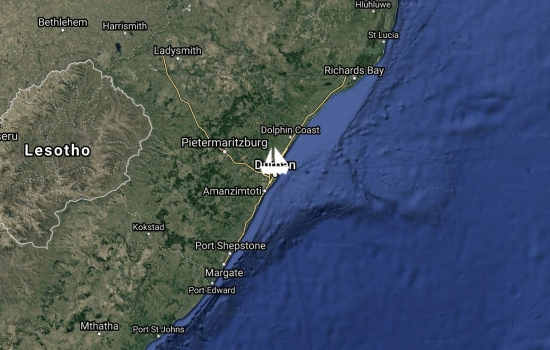
Avg: 5.6knts
24hr: 135.5nm
Arrived in Durban at 8:30am on the 5th of November - about a week ago. It's been an exhausting week and I was pretty exhausted before I arrived. But more on that in a moment.
We spent all of five days in Mauritius, parked up in what the locals like to call a marina, but which most yachties would call a boat-sized cheese grater. As always seems to be the case, the ARC Round the World Rally boats were in town ahead of us and had completely filled the marina. But we were able to talk another boat into letting us side-tie to them - a Norwegen family of 5 living aboard their little catamaran and sailing around the world. After a major challenge bringing the boat over from the customs wharf and docking next to them, all while being scrutinised by the ARC Rally sailors, we were finally able to relax. That is, until we realised that the swell created by cargo ships passing by outside the marina caused the boats to bob like rubber ducks, grinding them all against each other and the concrete walls around the marina. In a panic we deployed our ruined Genoa - still tied-up in a tidy bundle - as a giant fender between us and the seawall. With only a few gouges in our once flawless fibreglass hull, we could once again relax!
We didn't really get to see much of Mauritius, being short on time (Kate arriving in Durban on the 5th of November) and having to focus on maintenance projects. But the rest was wonderful, and it helped that there was a shopping precinct right next to the marina with coffee shops, bars and an international food court that made my eyes water after the very basic fare we were able to procure in Cocos Keeling Island. So sadly, hardly a very authentic Mauritius experience. But a welcome break all the same and a good opportunity to prepare for the remaining 1,600 mile trip south around Madagascar, then west across the much-feared Aghulas current to Durban.
It turned out that the ARC Rally boats were planning to leave the same day we were (we'd been gate-crashing the social events they'd organised for themselves all week!) although they would visit the nearby island of Rodrigues, an overnight sail away, which we would skip. I seriously didn't want to get caught up in the chaos that the 15 departing ARC boats would cause in the marina, so we waited until they were gone and took our time. That night we impressed ourselves as we flew past the fleet of ARC boats in the darkness, going considerably faster than they were, congratulating ourselves, until we realised that they'd probably deliberately chosen a slower pace so as to arrive at Rodrigues in the daylight. Still, it felt quite good to flash past a fleet of boats the same size as us :-)
Our trip began with a good fresh breeze that gradually diminished to nothing, leaving us to motor for 24 hours before a nasty cold front arrived and the wind came back with a vengeance. We spent 12 hours in pouring rain, big seas and all our reefs in the sails, flying along but getting very wet in the process, with huge cataracts of water clawing their way over the cabin top each time the bow plunged into the trough at the bottom of a wave. Fortunately the boat would shed the unwanted seawater over the sides before it could reach us in the cockpit, but it would usually surge far enough aft along the walkways that they'd crash into the cockpit in a giant explosion of water and douse the helmsman. It made for a long day but was otherwise quite manageable. At one point I was standing on the foredeck, right at the bow, tied-on with two tethers so I wouldn't get washed overboard, tying up some lines that had come undone when I felt a big wave pass beneath us from astern. The stern rose and the the bow dropped until the deck became level with the sea-surface all around me, and we blasted down the face of the wave at (what I later discovered was) 17 knots. It was quite a thrill and when I could finally unclench my hands from the rails, I returned to the cockpit with a whole new appreciation for life!
The weather began to calm down at 5pm or so and although the sea remained lumpy for another 24 hours, the show was over and normal conditions resumed. Of course, looking over the mast and rigging after the heavy weather I discovered that the stress cracks in the gooseneck had become substantially worse. It was time to get the mainsail down, but very, very gently. Worried that attempting to roll the sail away with the boat still rocking heavily due to the remaining waves, I elected to wait 24 hours. It turned out to be a good decision as the wind dropped further still, the waves calmed and the forecast for the rest of our trip showed that we would have the wind from dead-astern - perfect Spinnaker conditions. So when we finally rolled the sail away (still reefed all the way down after the storm) we did it so gently and carefully, and with so much focus on the damaged gooseneck, that we missed the fact that the sail wasn't rolling-up properly! A loose fold in the sail snagged on the boom and riiiiiiipppp... We put a 30cm tear in the sail! I was soooooo furious with myself! Our eyes were all on the gooseneck and I wasn't paying proper attention to the overall task. Sigh! It wasn't the end of the world - it was easily repairable and wouldn't stop us from using the mainsail again if we needed it. But given the state of the gooseneck, it would have to be an emergency before we'd get the sail out again. So we crossed the Aghulas current and made landfall at Durban under Spinnaker alone, turning-on the engine only when we arrived at the entrance to the harbour which was surrounded by anchored cargo ships.
We ducked and weaved our way through the anchored ships and called Durban Harbour Control for permission to enter, and Barry from Nautibuoy called and said "Helloooo!" They were anchored just inside the harbour entrance and would guide us to them so we could anchor next door. It was so good to have someone tell us where we had to go rather than wrestle with the usual uncertainty and worries about shipping channels, shallows, quarantine areas and moving ships the size of office buildings. With our anchor finally down, the Indian Ocean finally done, Barry and Wayne came to visit and we spent a wonderful morning catching up after last seeing each other back in New Zealand in April.
Being wonderful, Barry and Wayne had rented a car with which to collect Kate from Durban airport that afternoon. I was never confident of my arrival time (or date for that matter) and they had offered to collect and accommodate her until I arrived. So it was as much a surprise to me as it was to everyone else that I'd arrived in time to travel to the airport to meet her as she arrived. Strangely, she seemed far more fresh, relaxed and energetic - indeed, pleasantly perfumed - than I was! I think I still had salt in my hair! But what a special reunion it was.
Since then Barry and Wayne, who had already been in Durban for a week by the time we arrived, whisked us around all the boating supply stores where we replaced broken bits of equipment, filled gas bottles, organised a diesel delivery, negotiated a space in the marina, disassembled and removed the gooseneck and torn sail, found someone to re-weld and sew them back together, and generally get ourselves ready to move on. The people at the Royal Natal Yacht Club have been wonderful but the marina itself, somewhat dilapidated to begin with, was badly damaged by a major storm about a month before we arrived. Plus, the advice from everyone has been not to venture outside the marina at night, and if you go anywhere during the day, absolutely carry no bags, jewellery or money! So in truth, we're eager to get out of here! (Barry and Wayne, bless them had delayed moving-on so they could collect Kate if I hadn't arrived in time!)
From here it's about 800 miles to Cape Town. Ordinarily we'd make a trip like that in 4 or 5 days, but the weather here is a major factor and when it gets bad, because of the nearby Aghulas current, it gets *really* bad. The yacht club gave a presentation to all the cruising boats in town on how to spot the right weather conditions and which ports to make for between here and the Cape of Good Hope. It seems that you hop from bay to bay along the coast, travelling 100-200 miles at a go, then wait for the next weather window before moving on again. So we're currently waiting for the next weather window, hoping that we'll get our mainsail and gooseneck repaired in time to get away. Durban really is rather underwhelming :-(
Still, we've had endless lunches, coffees, brunches, dinners, snacks, breakfasts, and afternoon tea's with Barry and Wayne, sharing stories and endlessly catching up. Several other boats we know have already left for Cape Town so I'm sure we'll get to see them too as we move on. For now though we're planning a visit to a big game park where Kate wants to marvel at how vets manage with animals like elephants and lions! For me, I'm just pleased not to be sailing for a while and recharge my batteries - being in a marina (even one as worn out as Durban Marina) is a special treat, and getting away from the boat for a few days, even better still! So good to be among friends once more and very special that Kate coming of come to visit. Hopefully, from here on out, I should be able to sail at a slightly more relaxed pace rather than the breakneck speed I travelled from New Zealand to South Africa.
Avg: 5knts
24hr: 119.3nm
Yep, we made it. We tied up to the customs wharf at 7am yesterday morning after 2488 miles and 303 hours of sailing. To celebrate, we opened cans of beer and our last remaining bag of salt and vinegar crisps - it's not yet 8am!
Slight hitch, the customs wharf isn't actually a wharf at all. We've arrived at the main port for all the commercial ships which narrows and extends into the heart of the city, and all around the water there's a pedestrian walkway and shopping precinct. So we're actually tied to the pedestrian fence around the waterway. Not 20m back from the fence are cafes and bars - all closed at the moment, but a quick check with the binoculars reveals they open at 9am!
After 13 days at sea I'm preparing my order for the cafe - I have another 30 minutes in which to fine-tune it. Hopefully they'll see my need and serve me over the pedestrian barrier!
As we came gliding in to a stop at the sea wall, that's when I noticed the cafes. My eyes instantly went to the menus and opening hours displayed in the windows and off the instruments and situation. By the time my crew had convinced me to look back at what was happening, we'd actually run aground about a meter from the sea wall! I'd forgotten it's a new moon and so larger tides. So right now we're waiting for the tide to pick us up so we're afloat once more and can pull ourselves the last meter to shore. We managed to get some docklines around the handrails, but sadly, in my coffee-distracted state, we ran into the bottom pretty hard so we're not going anywhere.
Naturally, I checked that we'll be afloat once more with plenty of time to spare to pull ourselves to the shore and head into the coffee shop! I was planning some kind of rope-swing involving a halyard but seems that won't be necessary. Bit naughty since you're not supposed to go ashore until customs have cleared you in!
Next door to the coffee shop is a Chinese restaurant - that's where dinner will be coming from tonight! And on the other side is a bar - we'll be watching the football through the windows and hopefully the waiters will take our drinks orders over the barrier! So all in all, not a bad place to grind to a halt! :-)
***NEWSFLASH***
It turns out that you *can* check-in to Mauritius on a weekend - but the various offices all close at midday. Since we'd arrived so early I had time to get it done, but it was a 4 hour process! These people live for their paperwork - I stopped counting at 20 pages :-( By the time I was done my hand was aching with all the writing!
Then we walked around to the marina, also in the city centre, to see whether they had any room for us? Naturally they didn't, what with the fleet of ARC Rally boats in town. But the weekend-staff at the marina office didn't know that. "Yeah, sure! If you see a space then just take it. First-come, first-served!" And Lo and behold, there was an empty space, so we took it. It was the most complex space from a manoeuvring point of view and we had to enlist the help of a couple of other yachtties to take our lines, but it all went smoothly and we finally tied up, took a deep breath as began to relax.
It was at that point that the marina manager wandered past - not actually at work but just walking through town on his weekend off - and said that the space we'd taken had been reserved for another boat. He said that the other boat was elsewhere in the marina and that we could simply swap spaces. So I went to find the other boat - a Norwegian family with 3 kids aged 14, 11 and 9 - and explained what had happened. They told us that there was no way we could get into their spot because it wasn't deep enough for us, and they needed to move because they couldn't get the marina's internet where they were. Apparently they'd been waiting for several days for an opening to come up, and we crept-in and stole it! They were fine about it and agreed that instead us moving, they'd come and side-tie to us. So now we're one big happy family :-)
The only problem is that the wall we're tied up to is brutally rough and there's a fair bit of swell that comes into the marina when big ships move by outside. We have all our fenders *plus* the old genoa between us and the wall in the hope of avoiding getting damaged, but with the added weight of a second boat tied-up to us, I'm not confident. But we'll see how it goes :-(
So we waited for them to come alongside and tie up before heading back to the marina office and explaining that everyone was happy. Then I had to go to a bank and get money from an bank machine because the marina only takes cold hard cash! Which I did, only to realise that I was beginning to wilt, so grabbed a cup of coffee and a muffin - my first food and drink since arriving in Mauritius - and went back to the marina office to complete the paperwork and pay. So I've just made it back to the boat as the sun is setting and discovered that I hadn't asked the obvious questions like: Where's the shower? What's the code for the internet? Do we have any electricity? In truth, I'm so tired that I can feel the flesh on my face sagging - the underlying muscles no longer able to even support it's weight anymore.
We'll be leaving on Friday the 27th for Durban. Bob McDavitt has blessed the weather and agreed to do one last passage forecast for us. Just have to get the spinnaker repaired, gooseneck fixed, provisioning done, and a myriad of small repair jobs taken care of. Not going to have much time to relax but so it's so good to be tied-up and not to have boat responsibilities. Looks like we won't have any additional diesel for the trip to Durban - the fuel dock is reputedly a yacht-grinder. But we have more than enough. We only used the engine for a total of about 2 hours (9 litres of diesel) on the way here from Cocos. We used the generator plenty but that hardly uses any fuel in comparison.
Hi Tony, Great to be able to
Avg: 3.9knts
24hr: 92.4nm
Hi again. Apologies for the delay between updates. A slight technical glitch has kept my updates (delivered by email) from reaching the website. Fixed now, but I've been kept from writing emails by what is turning out to be a vigorous bit of sailing. It's hard to type and brace oneself at the same time! And it has been that way almost since we left Cocos, so pretty exhausting really.
Our replacement sail arrived in Cocos on Saturday - not Friday as originally scheduled due to a volcano in Indonesia spewing ash into the air and closing the airports used as backup options for landing should Cocos be closed for any reason. And planes aren't allowed to fly without their backup airfields being available. Sadly, after a disaster that happened a few years ago, airstrips on small islands are no-longer acceptable as backup options So we had to wait until the following morning to see whether the plane would even leave Perth. It did, and my crew all set off to West Island to collect it directly off the plane. No customs, no security, not even a cursory sniff from a detector dog! They lugged to 50kg sail back to Home Island (thanks to a friendly local with a truck for a ride the 8km from the airport to the ferry wharf!) where my one remaining crewmember met them in the dinghy and with 4 people, plus sail, they slowly made their way the mile back to the boat in the darkness. Much releived and immensely grateful to Doyle Sails in Perth, we had a celebratory night on board Tangled Up involving Rum and Coke!
The next morning, three singled-handed sailors all departed Cocos early while the three remaining bigger boats all languished, waiting for high tide and the additional clearance over the reefs before getting away. We hauled our new sail up - quite a challenge given the strong wind - and after only 3 tries, found we'd gotten it right. It was too windy to spend any time admiring the new powerplant but it appeared to fit well and we quickly stowed it away by wrapping it around its roller furler. What an immense relief to be able to sail away again under wind-power and not have to explore other options! We spent the rest of the day finalising preparations to get underway - most people would have gone for a test-sail to iron out any kinks in the new sail before undertaking any serious journey with it. Not us - our test sail would be all the way to Mauritius 2,336 miles away and commencing in a matter of hours. Still, time was growing short and I was confident we could address any problems we might find while underway.
We ended up leaving Cocos at 5pm on Sunday 8th October in company with the remaining two boats in the anchorage, who we soon left behind in our wake as we rocketed exuberantly into the night with our new sail. This trip has a reputation for being "fast but uncomfortable" and we were expecting a rude-awakening after 2 weeks being stuck in Cocos. So it was a bit of a surprise the following morning when we found ourselves almost becalmed. The weather forecast had shown a steady 15-20 knots of wind for the entire trip to Mauritius with 3-5m waves. Eager to make up time I suggested that we make the best of the light airs and hoist the spinnaker, which we did and despite our 2 week break, all went smoothly. Naturally, within an hour of raising it, the wind came back with a blast and caught us by complete surprise. With a series of brief gusts to 25-30 knots, the wind rose from 5-10 knots to 20 knots in a blink. Vastly overcanvassed we were dramatically rounded-up and laid-over on our side, the autopilot struggling to keep us down-wind blew a fuse and gave up releasing the helm and letting fate take control, then the weight of water now filling the spinnaker snapped the substantial stainless steel shackle that attached it to the anchor roller.
So with that opening move by the Indian Ocean, we decided to counter with a no-spinnaker rule for the remainder of the journey! Fortunately no one was hurt by the surprise maneuvers and once I took the helm and had us back on course - the spinnaker now flapping madly in the breeze, attached to the boat at only 2 points - we were back under control. However it turned out that the breadmaker (a real treat while underway, fresh bread!) had taken a dive off the galley bench and hit James squarely on the temple. Nevertheless, dripping soggy bread mix and smelling of yeast, James gamely fought the double vision to help get the spinnaker down and back in its bag. The spinnaker had other thoughts however. It had decided to wrap itself around our rigging in the classic but dreaded "hourglass wrap" fashion that is sometimes impossible to undo without sending someone aloft. It took hours but we finally subdued the beast and stashed it away where it belongs and should never have left. So with that slightly inauspicious start and only one or two small additional tears in the sail, we settled in for the remainder of the trip without the help of our spinakker.
We've made a steady 8.5 knot average for the entire trip so far with a top speed of 17.4 knots - presumably in a gust. (I would have had my eyes closed so I didn't see it!) The wind has been a steady 20 knots, enough to move us along fast in the waves. So the boat's motion is pretty vigorous and enough to prevent everyone from sleeping well. It usually takes a few days before sleep becomes a regular occurrence so we all went through an exhausted phase before returning to life again. A few maintenance issues cropped-up - a wastewater pump burned out when a foreign object (a rubber foot from some other bit of equipment) was sucked into it. I had to replace it and spend most of that day with my head down under the floorboards in the front of the boat. I came away very nauseous and exhausted but the blue sky conditions outside soon had me back in good order. We had a change appear in the weather forecast with a squash-zone putting an appearance right across our track which translates to substantially stronger winds and bigger waves. So we took a detour north in the hope we could remain on it's edge and miss the worst of it. Prior to the forecast wind arriving I went over the mast and rigging with a fine-toothed comb looking for any potential problems...
And naturally, I found one! The bit of hardware that connects the boom to the mast is called the gooseneck - a sort of universal joint. There's a tremendous load on this spot so it's made of very substantial materials Looking closely at it I could see stress fractures creeping into the metal of the "knuckle", the bit right in the middle. Sigh! Such a fundamental, structural part of the rigging simply cannot fail and with a big blow coming, I tknew it had to be replaced. So we spent the morning planning how on earth we'd swap it out for its spare. (It's one thing to have a spare knuckle, but its another thing entirely to know how to replace it!) We dropped the mainsail, rigged a big cradle from the masthead and secured the boom with more lines than the QE2 then detatched the boom from the mast. Quite a project on a moving platform, doing 8-10 knots in 3-5m seas! When we finally had it all back together again, I was once again exhausted - mostly just from having to hold on all the time - and crashed into bed stinking of WD40.
We reached 13 degrees north - a substantial detour north that we hoped would keep us away from the worst of the wind - turned west, and awaited the wind. For the most part we saw a modest lift in the wind to 25 knots which lasted for 48 hours, but overnight we had about 6 hours with long spells of winds upto 37 knots. It was a long night and James doggedly steered the entire time while I worked the sails and kept him fed with muesli bars, cups of tea and bowls of Heinz ravioli! The autopilot was on the edge of its ability to cope so hand steering was much kinder on the boat and crew, but its an exhausting undertaking and James crept away as dawn approached and slept all the following day. With dawn came a drop in the wind - back down to 25 knots and a steady decline (about 2 knots per day) since then. The wind-built waves have been slowly subsiding ever since and are still at 3-4m as I type this. Today though the wind should drop to 12-14 knots - which will feel like dead calm! - and a good job too, as yet another maintenance issue cropped up...
In preparation for the wind we decided to put another reef in the mainsail. Given the already string wind and sizable waves, I like to have the engine running to assist - it would be something of a group effort and key to success was to turn the boat up into the wind and waves and hold it there while the sail-change happened. So I took the helm and directed the crew (who are pretty well practised by now) through the procedure. Just as we completed the reef, the engine overheat alarm went off. Fortunately we didn't need the engine any more so I quickly killed it and filed it away for future investigation. I eventually concluded that the raw-water cooling pump on the engine had died - not an uncommon problem - and that the little rubber impeller needed replacing. It's not a massive job but it's made very awkward by the fact that you have to disassemble the galley to get access to the pump which is on the side of the engine. Removing the galley cabinets is tricky because they're full of pots and pans and very large and heavy. It simply wasn't something we could do in the conditions we had at the time. So big blow coming and no engine...
The conditions are still too vigorous for me to repair the pump even now, 3 days after the blow! But later today or possibly tomorrow morning, the conditions are supposed to get as light as we can hope for, so I'll do it then. We're still 2-3 days out from Mauritius and so long as we get it done before we need to motor up the narrow entrance channel and anchor/dock/moor, we'll be fine. In the meantime, the generator - which works hard on this boat as it's needed to power the freezer, the watermaker and charge the batteries - sounded its engine-overheat alarm. It's raw-water cooling pump had also decided to disintegrate! What are the odds? I had last replaced them both in Fiji last year and had neglected to replace them again since - they should be replaced every 500 hours or so. So my own fault for not being diligent with my maintenance record keeping. Fortunately, access to the broken pump on the generator is good and switching out the bad impeller is easy. So hopefully the engine replacement goes as well...
Last night we watched Calendar Girls (British movie with Helen Mirren and Julie Walters) and ate freshly baked scones courtesy of James, with jam and condensed milk in place of cream. Armed with cups of tea we were all very British for a moment and thoroughly enjoyed the movie. We're all tired, I think - I know I am. This trip has been incredibly hard work - "fast but uncomfortable" is entirely apt. Being down below is stiflingly hot because we can't have any of the hatches open due to ocean spray, and being in the cockpit is like taking a surfing lesson. The air is filled with water which the wind picks-up and carries horizontally. It's like being on the receiving-end of someone chucking buckets of water at you. The water is warm at least, but it makes it hard to relax. We've got another 500 miles to go and expect to arrive either Friday night or Saturday morning. Sadly, the channel is narrow and windy so you're not allowed to enter outside of 6am to 6pm. Better have our engine going by then. The other problem is that we can't clear customs on the weekend so we're likely to be confined to the boat for two of limited number of days available to explore Mauritius.
I'm thinking that after this trip, a brief visit to a marina is on the cards so I can get some quality rest before the final leg - Mauritius to Durban, around the southern end of Madagascar, where we have the Aghulas Current to cross...
Interestingly, that's approximately my own personal half way point in the voyage from NZ to the UK!

Avg: 7.7knts
24hr: 184nm
Finally made it! We're here in lovely Cocos Keeling, anchored behind tropical-looking Direction Island - white sand beach, palm trees, crystal clear azure water and sharks swimming all around us. We entered the pass into the lagoon at 8am local time after a 13 days at sea. The last two or three days had seen the wind really get up, and the waves along with it. So turning the corner around Direction Island and feeing the ocean waves disappear was just blissful. The wind hasn't abated any and Direction Island, having an elevation of only a few feet, doesn't offer any protection. So the wind is still howling in the rigging and the boat hunting back and forth against the anchor chain. But you really know you've arrived when you can reattach the lock on the gimballed stove, put away the travel mugs and have a cup of tea out of a real China mug :-)
Sadly, there was one fatality during the closing stages of our journey: our trusty genoa, the big sail at the front of the boat - the real powerhouse sail. The sail tore in two at about the halfway point of our journey when the wind died away to nothing overnight and the continuous slatting back and forth caused a seam to fail. After 2.5 days of hand-sewing it back together, it did an admirable job of pulling us along in the strong winds those last couple of days. But just as we were rolling the sail away as we approached Cocos, the mad flapping back and forth ripped it in two once more. In our haste to get tucked-in behind the island and get the anchor down, we ignored it - a problem for next day!
There's a tiny little designated area for visiting yachts here and three other cruising boats were already installed. From a distance I could see it was a small space and wondered how on earth we would fit. But it was bigger than it looked and we finally anchored close to the beach in about 4m of water. (Anyone who knows me will appreciate that I *never* go in water shallower than about 10m so this was a big moment for me - I think I'm finally growing as a sailor!) When the customs officials came aboard he informed us that we'd unwittingly done the right thing as the following morning, an organised boat rally called The ARC Round The World Rally would be arriving. The tiny anchorage would contain 19 boats! As surprising as that news was, it didn't stop us from immediately sleeping for 14 hours straight. And upon awakening, here we all were - 19 cruising boats all jammed into a minuscule bit of paradise. I'm tempted to get my fenders out!
So it was all the more mortifying to have to unroll the shredded genoa and wrestle with it in the merciless wind into an only-a-sailmaker-would-ever-think-it-was-big-enough sailbag, while 18 other boats enjoyed the side-show, sympathetic but silently saying prayers of thanks that it wasn't their problem. Sails are such critical parts of a sailboat and yet so large that there's almost no chance of being able to carry spares! We'd already had all the luck we were going to have when we found enough sail-repair materials to piece it back together the first time. But that damage done the second time around had reduced the sail to rags. Due to certain inflexible laws of physics, sailboats require *two* sails, one fore and one aft, in order to sail in a straight line. Without a headsail we were quite seriously stranded in paradise!
Enter the miracle of modern technology - with the help of my UK-based support team, I was immediately put in touch with a list of sailmakers in Perth, Australia. Rumour had it that Cocos received a weekly cargo flight from Perth and that if we could find a sailmaker brazen enough to think he could put a whole new sail together in record time and get it to the international cargo terminal for the next flight out, then our problems would be solved! So, i put the now working satellite phone through its paces and called every sailmaker in Perth. Only one felt confident enough to take on the challenge and thank goodness that he did! So with his guidance, we dropped the shredded sail into the dinghy and took it ashore where there was some shelter from the wind, and tried to piece it back together, jigsaw-style so we could measure it! To give you some clue about the state it was in, Madi was equipped with snorkel and mask and sent to the sea-floor to retrieve several wayward jigsaw pieces :-(
Several hours later I emailed the dimensions away to the sailmaker who, I imagine, girded his loins and hopefully got stuck-in! So here we are, at the mercy of so many variables which all must go our way if the new sail is to make it here to Cocos on the 6th October cargo flight! We can't leave without it but then we can't stay any longer either... Fingers crossed!
Avg: 10.5knts
24hr: 252.6nm
Hi again! Well it has been a difficult few days. The wind has been incredibly light - not at all like the weather forecast said it would be back when we left Darwin. I guess that just goes to show that weather forecasts are only ever good for the first 2-4 days and after that it's anyone's guess. We've been seeing winds in the 5-10 knots range ever since they returned on the 3rd day out from Darwin. We were expecting those first few windless days, but from that point on there was supposed to be winds in the 15-20 knot range. But no, we've had next to no wind and been suffering from the heat and humidity during the day despite a little chill in the air each evening.
It has proven to be a very good decision to have made our way northwards to meet the west-setting ocean current. So far it has provided us with about half our progress, and the spinnaker with the other half. The two combined have resulted in an average speed so far (since we turned the engine off) of around 5.5 knots. Not too bad, but it would have been 4 knots without the current!
One downside to the light winds (aside from the obvious lack of progress) is that we're rolled from side to side by the ocean swell. It's very gently but it causes the boat to roll in an exaggerated fashion that makes moving around difficult. Plus it causes the sails to slam and bang as they're wafted back and forth in the still air. We would have been better taking them down despite the little bit of forward progress they were contributing. The reason I say that is because when the sails slat like that, they tend to worry any creases and folds in the sail ceaselessly. The constant worrying, in our case, caused our genoa (the big headsail) to rip in two!
You tend to see headsails getting torn to pieces in heavy winds, but light winds are possibly even more destructive thanks to the constant slatting. Very disappointing! I was aware that the sail was worn out and needed replacing but I'd hoped it would see us to South Africa. In fact, if we'd had any wind this last week, even unexpectedly strong wind, I'm sure it would have been fine. So for once I was grateful for the light winds as it meant we could lower the sail onto the deck and set about repairing it, without the wind trying to blow it away.
It has taken two days of non-stop sewing and all of the sail-repair material I had on board to repair the 4-5m L-shaped rip. We rigged a sun shade over the boom to keep the worst of the heat off, draped the torn part of the sail over the boom and with one person sitting on one side and another sitting opposite, pushed a sewing needle back and forth to each other for two straight days. We'd stop overnight and tie the bunched-up sail to the lifelines, ready to resume in the morning. It's repaired now except for the corner of the L which requires a circular patch. Good job too as the wind is forecast to return tomorrow morning and make its way up to a steady 18 knots. With that sort of wind we'd have had to have waited until arriving at Cocos to make the repairs.
So now it's time to think about getting a new sail made in South Africa - hopefully something I can organise by email so the sailmakers can have it ready for us when we arrive in Durban. It would be a long trip to the UK from South Africa without a headsail! I just hope the repair lasts for the trip to Mauritius - a notoriously windy passage that will really put the sail through its paces. I'm not confident that it will so we may be reduced to sailing with the staysail, a handkerchief sized sail that's usually only deployed in heavy weather.
Anyway, we'll shortly be getting the sail back aloft so that when the wind arrives we'll be ready for it. In the meantime the spinnaker is doing all the work (as it has ever since we turned the engine off) but still only moving us along at 3-4 knots. If we can pick up the pace in the increased wind then we'll be arriving in Cocos on Tuesday or Wednesday next week, the 26th or 27th of September, exactly 14 days after departing Darwin.
We've been going for 3 days now and have almost crossed the Timor Sea, heading for the southwest corner of Timor where we'll pick up the south easterly Tradewinds and a raging ocean current - 2.5 knots in places that'll help carry us west! There's been no wind for though - we've run the engine for 38 hours since leaving Darwin and used 180 litres of diesel doing so. Keeping back 160 litres for the generator (ie. the watermaker and freezer) that means we've already used 33% of our propulsion fuel to travel 300 miles or 7% of the way to Mauritius. Sigh! It's quite a dilemma.
I'm confident that once we reach the wind and current we won't need the engine again for the rest of the trip aside from the occasional bit of anchoring or assistance with sail changes. I imagine we'll be arriving in Mauritius with the engine running on diesel fumes though. Hope we have enough in reserve to keep the generator going until then too! Might have to make a little spreadsheet...
It's completely flat calm and has been since we left Darwin - eerily calm. Not even an ocean swell. Such unusual conditions - rare to ever see this in the Pacific. There are clouds of jellyfish in the water too - not obviously deadly ones, but I wouldn't want to mess with them all the same! We're taking a course that's more northerly than usual so we'll miss Ashmore Reef and the surrounding shallow waters. The hope is that we'll pick up the ocean current sooner that way. But I'm also hoping it means we'll avoid the worst of the fishing boats and oil rigs that are common in the area. However we'll shortly come within 5 miles of the Timor coast so I imagine we'll see lots of coastal fishing boats instead. So many imponderables...
Caught several fish yesterday but they were so big that we lost them trying to haul them aboard! We've now lost our two best lures so we've had to improvise using a pair of colourful old socks. No bites yet but we're confident! We did catch a small tuna - just enough to feed the 5 of us last night. Bit disappointing to lose the big fish and what were clearly two very effective lures! Can't believe it but I'm actually coming around a bit and at least cheering people on when they have a fish on the line!
It's been pretty easy so far - the hardest parts are the constant noise of the engine and the heat. With no breeze we're all sweltering. Might have been wise to have stayed in Darwin for a few days until some wind materialised, but once we get to Timor the conditions are absolutely perfect for the remainder of the trip to Cocos so I made the executive decision to go despite knowing we'd have to motor for the first couple of days. Still, we've been eating fresh salads, fruit and veggies so all very pleasant. I'm sure by the time we arrive in Cocos we'll be desperate to find a market :-)
I had a night without a watch last night so a full night's sleep. The wind (a gentle breeze about 4kts) showed up at about 6pm yesterday from the east - the perfect direction and enough for us to make 2kts of boat speed. So we killed the engine and ghosted through the night.
It's was such a relief to turn the engine off plus the modest breeze has everyone feeling so much cooler. Because there's been so little wind and we're still a long way from land (where I'm afraid the fishing boats will start to appear) we've been having just one person on watch at night, rotating people every 3 hours. James and Markus insisted that I have the night off and took longer shifts to cover. I was happy to let them but I hardly needed it at all.
We had stopped earlier in the day for a break from the engine noise. It was stiflingly hot and impossible to feel comfortable so I suggested that we all take a swim. We spent about an hour diving over the side and snorkelling around the boat. It was much better than trying to cope with the heat onboard but the sea was so hot that it offered almost no cooling relief. Plus we had to be on constant guard for jellyfish which seemed to be flying past us in clouds back when we were motoring. But with the engine off we only saw one or two - which didn't look like the sort that could kill you - and the water was so crystal clear that they were easily seen and avoided.
I'm laying in bed having just woken up and feeling the incredibly gentle movement of the boat and listening to the swish of the water running along the hull. So very calm and peaceful. I should really get up and get the spinnaker up so as to make the best possible use of this breeze. I'll give myself another few minutes then do it. We've had three low-progress days and now, even though we're no longer burning diesel - are going even more slowly. So I really must try to keep the speed up and I've no excuse since I had the whole night off!Hi
Arriving in Darwin is a tricky business as the city is located just outside Van Diemen Gulf, the body of water that's trapped between the north coast of Australia and Melville Island. To get to Darwin from the east one has to enter the Gulf through the narrow (15 mile wide) Dundas Strait and exit through the narrower-still Clarence Strait, a distance of about 100 miles. The tides fairly rip through these two Straits and there's no chance that a low power vessel like a sailboat will make any progress against an adverse 7 knot current. So you anchor outside the entrance to the Gulf (Cape Don) and wait until slack tide, then ride the current into the Gulf. It'll get you about half way before it turns and starts going back the other way, but as you're now in the widest part of the Gulf, the current is no longer as extreme. You sail hell-for-leather against the current trying to stay put at least, and 6 hours later the tide turns once more and carries you towards the reef-strewn, mind-bogglingly narrow Clarence Strait. The north channel through the Strait is less than a mile wide!
Our transit through the gulf began at 2am when we raised the anchor in the darkness, keeping a wary eye open for the 4m crocodile who reportedly inhabits the bay. (I had visions of the boat drifting away during the night as a result of the crocodile biting through our anchor chain, but thankfully he didn't put in an appearance!) And then we started to motor, then sail towards Cape Don. We'd reefed our sails in anticipation of strong winds and weren't disappointed - the land funnels the wind into the narrow opening, turbo-charging wind-powered things like sailboats. Having cleared the Strait our speed picked up still further as the current began to build and we raced towards the first channel marker.
Naturally, because it was dark, we were doing 10+ knots in strong wind, in a reef-strewn waterway, our AIS box decided to throw-in another variable and alerted us to a container ship coming the other way. Despite our different sizes (cargo ship = 200m, us = 17m), thanks to the current assisting us and slowing the cargo ship, we were both going to round the marker at the exact same moment. And because boats generally drive on the right, and because at the marker we would be turning right, we were going to get squashed between the cargo ship and the marker. So we called the sleepy watch-officer on the ship and asked if he could make a little sea room for us, which he kindly agreed to do. With the marker a half mile to our right (and more to the point, the shallow reef it's mounted on as well) and the cargo ship a half mile to the left, we shot through the gap in the complete darkness like a boat out of hell.
After that things calmed down, the sun came up, the wind eased and the current turned against us. When the wind blows contrary to the current, you get steep, closely spaced wind-waves which grow taller and taller until the direction of either the wind or current changes. So our speed through the water began to drop thanks to the waves and our speed over the ground dropped further still due to the adverse current, until we were making a mere 2-3 knots towards Darwin. It was a bit like jogging on a treadmill! Still we resisted the urge to put the motor on and held our own against the current under sail alone.
Finally the current changed once more as we approached the narrow channel through the Clarence Strait and suddenly we were effectively spat-out towards Darwin at a round 10 knots. An hour later we arrived at Fannie Bay and anchored. It had taken us about 12 hours in all to do the 100 miles but it had gone pretty smoothly all things considered!
So here we are! This is where my crew depart and I must find new sailing companions. I'll be sad to see them go as we've all worked well together and enjoyed each other's company immensely. We've sailed 3,300 miles together - not bad considering a Paul and Ermina had never sailed before! They're now bonafide blue-water sailors. I have allowed a couple of weeks in Darwin to find new crew, reprovision and take care of the long list of maintenance tasks. From here it's another 6,000 miles to South Africa and the Cape of Good Hope, via Christmas Island, Cocos Keeling Island and Mauritius. The longest leg of that trip is a mere 2,000 miles - probably 2 weeks or more of non-stop sailing. After that, there's only the Atlantic left to do!
Nearly home :-)
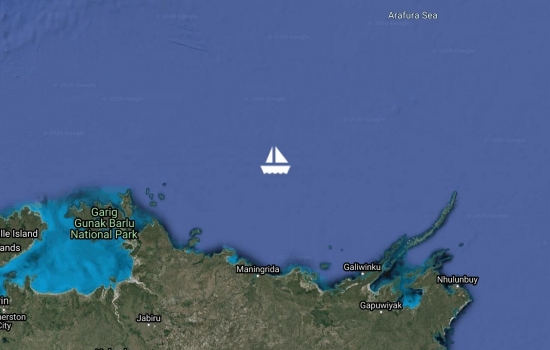
Avg: 6.6knts
24hr: 158.2nm
We're now well over half way to Darwin, the Gulf of Carpentaria a long way behind us. The wind has been back and forth between 8-15knots, always from the south east, so perfect really. But the ocean swell caused by the wind blowing over the Gulf of Carpentaria has made for a pretty rolly first-half of the trip. Not much sleep for anyone unfortunately. Plus, given the heat - 28-30 degrees C each day - we're all a little tired and grumpy! But now that we've rounded Cape Arnhem we're no-longer feeling the ocean swell and the conditions are near-perfect. We've had a good night's sleep, eaten well, and are beginning to relax into the trip. It's surprising just how exhausting the constant rolling motion can be - you can't even sit down without having to brace yourself against something.
The day before yesterday, just as the ocean swell was beginning to fade, the line that attaches the spinnaker to the top of the mast snapped. Down it came like a lazy dream and lay flat on the water where it was whisked away, streaming out behind us like a giant sail-slick. It was quite a shock watching something so massive and so close-by do something so completely unexpected! We began to drag the sail back onboard which was quite a feat - the heavy rocking-motion made it difficult to lean over the lifelines to pull it up out of the water, and the boat's residual speed created a tremendous drag on the sail. And once the sail was on deck, the wind would try and blow it over the side again, so we wrestled with it for 20 minutes before finally managing to stuff it down through a hatch into the cabin below. Fortunately we didn't get it wrapped in the keel, propeller or rudder - that really would have made things difficult.
Naturally, when something drastic and highly visible goes wrong like that, despite being in the precise middle of nowhere, the crew of a passing container ship got to enjoy the show. Sigh! With the sail back onboard, we rolled out the genoa (the smaller, everyday headsail) and got back underway. We used the spinnaker halyard from the other side of the mast to re-hoist the spinnaker and pull it into it's storage sock, leaving it to hang there like a long, wet sausage to dry out. Then before dark, we lowered it back through the hatch and spent the night sailing under genoa alone, making 4 knots instead of 7. We all slept well thanks to the diminished ocean swell and not having the spectre of the spinnaker up all night. It's such an unforgiving sail that rule number two of "Sensible Sailing" says "Never sail with the spinnaker at night!", a rule that we've broken once or twice on this trip already. But we were quite fortunate that the halyard snapped during the daylight - managing it at night would have been a fiasco! We discovered the problem was a worn-out spinnaker halyard (rope) that had simply snapped - it was very old and sun-damaged and had decided that today was the day to give way. We wouldn't be able to use the spinnaker again on a port tack without replacing the halyard, which meant that someone had to go up with a replacement. (Always carry a spare couple of halyards - Sensible Sailing rule 17a, I believe!) Jason and Paul were positively champing at the bit to volunteer, whereas Ermina (far too sensible) and I (have done it before and know *precisely* how awful it is) were keen to let them.
Jason drew the short straw, and with the boat rocking and rolling from the ever present swell, was hauled up the mast to the top where he hung-on bravely (shocked, I'm sure, at just how high the mast is!) Once there, he fed a weighted, lightweight line down through the opening at the top of the mast to Paul who, standing on the boom, used a hook to catch and pull the line out through an opening at the bottom of the mast. Then, using the lightweight line, we pulled the spare halyard up the inside of the mast, over the block at the top, tied it to Jason, and then lowered him back down to deck-level. Everyone did an excellent job to fix the problem, and Jason especially for managing not to throw-up due to sea-sickness. The boat's motion at deck level was bad enough, but is always magnified greatly at the mast-head.
The whole time he was up there, there was a pod of dolphins swimming around us causing a certain amount of distraction that probably caused the project to take a little longer than it should - much to Jason's annoyance! Now we're back in business again with nothing but a small tear in one of the spinnaker panels. I have a sail repair kit but none of the lightweight material that's appropriate for the spinnaker. So we're hoping the tear doesn't grow any bigger. Hopefully it'll be easy to repair in Darwin once I locate a bit of material.
So that's all the excitement we've seen so far this trip - watch this space, though... You never know what's coming around the next corner!
We made it to Thursday Island without incident - the remaining 60 miles through the Great Barrier Reef was actually pretty simple and we joined the main shipping channel heading north up the coast. The one surprise was the amazing number of ships traveling in the channel causing us to hug the edge of the channel, pushing us closer to all the reefs than I would have liked. Still, accidentally bumping up against a reef sounds a little more forgiving than close-call with a 250m long cargo ship! We anchored at the tip of Cape York, the northernmost point of Australia in the lee of a tiny island, with Thursday Island visible on the horizon 20 miles away. We didn't think we'd get there before dark and the reefs in the area are even more extreme than we've seen so far. So we spent the night tucked in behind York Island and set off the next day on the rising tide. (Movements up here are all dominated by the tides - 7 kts rushing through the Thursday Island area!) As we were pulling up to our anchoring spot we were buzzed by an Australian Border Protection Force helicopter who quizzed us on the radio about who we were, where we were from, how to spell our boat name, how many people on board, etc. He was very keen to know wether we were all caucasians! He told us we couldn't go ashore or else risk time in jail. He then did a couple of low-level passes and (presumably) took some photos. He seemed happy enough but it was a good job I'd put up our Q-flag back when we entered the GBR.
And on the subject of the GBR, what a disappointment! There's less to see here than there was in New Caledonia. You're not missing anything - believe me! I guess that in order to see anything special you've got to take your life in your hands, put a snorkel mask on and get in the water. Not me! Turtles are cute, sharks are vaguely interesting, but crocodiles and killer jellyfish are a big no-no! We did see the biggest turtle I've ever seen though, plus a pod of three small dolphins raced us in our bow wave for 30 minutes today! So not all bad.
Anyway, we arrived at T.I. around 2pm and cleared customs and biosecurity (AU$290 please - Ka-ching!!) with minimal fuss although a very thorough search of the boat. Then we moved the boat a little closer to town (Port Kennedy on T.I.) and went ashore for celebratory burgers and chips. The howling wind caused us to get soaked in the dinghy (on the way out *AND* on the way back) but a taste of solid ground and a world that extends beyond just a few meters in any direction was most welcome. It was Tuesday 15th of August, so I guess it took us 12 days, although that includes 24 hours of rest in the Great Barrier Reef, and one night anchored nearby waiting for daylight before approaching T.I. So that makes 10.5 days to cover 1,600 miles - or 152 miles per day for an average boat speed of 6.4tks. Considering that for the first 5 days we probably did an average of less than 5kts, that means for the latter 5 days we around 205 miles per day or an average speed of 8.5kts. And in those first 5 days we used around 140 litres of diesel, so that's 4.7 litres per 100km. Not bad on the whole.
It's been overcast, grey and raining on-an-off here. If it wasn't so warm you could imagine it was the UK! Lol! The weather is unusually bad with much stronger winds and lower temperatures than usual. The temperature seems fine to me, but the winds are relentless - every day it blows a steady 25kts with visits from Mr 30kts whenever you least need it. Plus, where we are right now, the entire Pacific Ocean drains into the Indian Ocean through a gap that's about 80 miles wide and as deep as a swimming pool. So the currents are enormous. Where we anchored, the boat speed sensor was telling me we were doing 2.5kts - and that's in the most protected part of the anchorage. And just in case that doesn't make life interesting enough, there's a constant flood of giant container ships, super tankers and bulk carriers zipping through the Prince Of Wales Channel like it's a motorway. The channel is the only bit of water that's deep enough for them, and because of all the reefs (did I mention the reefs?) we have to hug the edge of the channel in order to head east to Darwin. Just hope no-one's asleep at the helm! We did have one moment of excitement... Getting to and from the shore in the dinghy has generally been pretty frightening - the wind is so strong and the waves are big enough that everyone in the dinghy gets soaked. It doesn't help that there are signs everywhere saying "Beware of the Crocodiles" so you *really* don't want to fall in! To cap it all, when we unpacked the dinghy and reinflated it they didn't put enough air in the tubes, so it was pretty soft. That really didn't help.
So when we got back to the boat after on particularly wet trip, I asked Jason and Paul to add a little more air. While sitting in the dinghy with the foot-pump, Jason managed to unscrew the fitting through the rubber tube/hull. The entire fitting fell out - one half inside the tube, the other half onto the floor of the dinghy. The tube totally deflated and the dinghy - now consisting of a single inflated hull-tube - began to sink, outboard and all. Paul had the presence of mind to quickly lower the dinghy davits and tried to lift it up out of the water, but with the weight of the outboard and so much water inside, all he managed was to prevent it sinking further! Still, we managed to rescue Jason, get the outboard off and bailed-out the water from within, then lifted it onto the cabintop and set about seeing if it could be repaired. Fortunately we located all the pieces and were able to put them back together. It reinflated again and the outboard wasn't damaged by its partial immersion, but I get the sense that the poor dinghy is well past its lifetime. I just hope it makes it back to the UK but if it does, I suspect it'll have to be retired at that point.
After a 48-hour break at T.I., including a big reprovisioning trip to the grocery store, we were ready to depart. So at at baout 10am this morning we pulled up the anchor and set off for Darwin about 750 miles away. We're currently crossing the Gulf of Carpentaria and, guess what... The wind vanished! Can you believe it? Incredible timing! 30 knots for nearly 10 days straight, and then zip! Once we were out from among the islands, the breeze returned - a steady 8 kts from the east. So the spinnaker's back up and we're making about 6 knots on a smooth sea. All things considered, it's about perfect! So here we are, on the road again...
Avg: 7.7knts
24hr: 185.4nm
We made it! Yaaayyyy!! We're here, anchored inside the Great Barrier Reef. THE GREAT BARRIER REEF!! Our experiment in extreme sleep deprivation is over and the results are in: IT SUCKS! If you're the kind of person who needs their 8 hours of regular sleep, then offshore sailing *ISN'T* for you!! Take my word for it!! Now that we've established that, let me give you a news update...
The problem was that our arrival time at Raine Island (the entrance into the GBR) was going to be around 2 or 3am. We'd tried slowing our approach so that we'd arrive later in the morning but the vigorous winds over the previous week had stirred up some pretty large seas and we needed a lot of power from the sails just to stay on course and remain in control. Plus the prospect of getting tucked-in behind a reef, anchor down, and having as much sleep as we wanted was just too good to delay! So we all agreed that we'd deal with the pass in the darkness.
This meant that we wouldn't get to see any of the comforting signs that we were in fact arriving at the hoped-for pass, and not just rushing headlong into an anonymous wall of coral reef. The big giveaway was supposed to be the tower on Raine Island (built in 1864 to help ships locate the pass) which, in the daylight, would have been obvious. But in the darkness, the best we could do was search for it on the radar. Sadly, in 1864, radar reflectiveness wasn't a high priority for even the most forward-thinking of architects. An intermittent blip in approximately the right spot on the radar-screen, together with crossed-fingers, gave us the confidence we needed to head in...
With everyone on deck watching for hazards, we made it through the outer reef without incident and turned-up into wind, dropped our sails and began to motor the 5 miles up-wind to our anticipated anchorage. With the ocean waves now being blocked by the barrier reef, suddenly the boat was no-longer rocking and rolling. It was like exiting from a 5 day roller-coaster ride. Absolutely wonderful! Unfortunately we also discovered what 30 knots of wind feels like when you're facing directly into it, rather than heading away from it. Even with the engine at full power we weren't moving anywhere. Absolutely not-wonderful! So we abandoned Plan A, turned back down-wind, rolled out a sail and set off for the next potential anchorage, 16 miles away. In precisely the manner that sensible sailors never do, we once again rocketed through the reefs in the darkness following a well-published track laid down by previous sailors heading for Thursday Island. The sun was up by the time we arrived at our anchorage, a submerged ring of coral that just breaks the sea-surface at low tide. We anchored on the lee side of it, but the sea-floor fell away so steeply and the wind was so strong that we knew we couldn't stay. Sigh! Looked like Plan B was going to be a bust too! The next stop being another coral island 48 miles away which, given the strength of the wind, was 6 hours away. In "Ken's Torres Strait Passage Guide" the source of all our knowledge as far as traversing the Great Barrier Reef, Ken described this next stop as "well protected". The promised land! Having had our primary anchorage denied us by the wind (should've seen that coming!) and our backup anchorage denied us by poor holding (not entirely my fault as the chart showed a gently sloping sea-floor), Plan C was born. With the GPS in Anchor-Drag mode, we all had hot showers, an hour's nap and a quick bite to eat before motoring into the wind the pull the anchor up, raise our sails and get moving again. But this time in bright sunlight! 6 uneventful hours later, with each of us getting another hour's sleep en-route, we arrived at the nameless coral island just as the sun was about to set. The anchor hit the bottom in 8m of water and a delightfully shallow slope. The wind - blowing 20-25kts all day - has built some considerable wind-waves but we're nicely protected by the island. Tomorrow the wind is forecast to return to 25-30kts so we'll just relax and let it all blow over staying here for a couple of days catching-up on sleep, doing some laundry, cleaning the boat and tease the crocodiles. (The latter is only partially a joke! Paul is, right now, trying to catch one with Harry's fishing rod!) So we're half way through the GBR already - Thursday Island and official entry into Australia is only 60 miles away. A day trip. But we'll eat the last scraps of food we'd otherwise have to hand over to the biosecurity people before we think about moving on :-)
Excellent progress..... Well
So relieved you are inside
Avg: 6.4knts
24hr: 154.8nm
Hello again. I just thought I'd write an update from around the half-way point. It was 1,400 miles from the pass out through the reef at New Caledonia to the pass that will let us inside the Great Barrier Reef (called Raine Pass). The chart-plotter (our main navigational tool) tells us that we passed the half-way mark during the night and now we have only 659 miles to go. Always a good psychological landmark on a long trip like this. We're all a bit tired from the interrupted sleep pattern caused by keeping watches through the night. In fact we're beginning to look like we're making fatigue a lifestyle! But we're all in good spirits. It's been a frustrating trip at times - the tradewinds which can usually be relied upon to blow from the south east at 15-20kts have been intermittent, with 5-10kts having been far more common. In 5kts of wind, even with the spinnaker up to catch as much of the breeze as we can, we only crawl along at 2-3kts. At that speed we're subject to the ocean swell which rolls us around uncomfortably, causing the sail to collapse and re-fill with a loud bang. So although we put up with it during the day, at night we put the motor on which moves us along at a good 6kts. Feels much more like progress! Besides, chapter 2 of that book called "Sensible Sailing" is titled "Never Sail At Night With The Spinnaker Up". (A rule we've broken a few times on this trip so far!) Still, it is a beautiful thing seeing the spinnaker move us along so quickly in the light breezes we've been seeing. In 10kts of wind, the boat will 5-6kts which is as good as the engine can manage. The spinnaker however is silent, doesn't add heat to the boat's already over-heated interior, and doesn't produce exhaust fumes. (Because we're sailing down-wind, the exhaust fumes blow forward over the boat making everything smell!) The spinnaker has never worked so hard as it has on this trip. Of course, along with the spinnaker comes the possibility of the boat being laid-over on it's side by a quick increase in the wind. I believe that chapter 3 of sensible sailing says that the art of sailing isn't about getting your sails *UP*, it's all about getting them *DOWN* at the right time! Anyway, it looks like today is the spinnaker's last day of duty - another day of 5-10kts today but from 4 or 5pm the wind increases to 20kts, then maybe 25kts tomorrow. So the rocket-ride we expected this trip to be may actually begin this evening. We've run the engine all night to help keep us moving in the light breeze, but also to fully charge the batteries. This boat has electric everything (winches, autopilot, etc) so we'll benefit from the fresh charge once the wind picks up. I think we're all looking forward to putting the playing-cards away and actually getting to do a bit of sailing! (Hope that's not famous last words :-) We left the pass at New Caledonia at 8am on the 3rd of August, and it's now 8am on the 8th, so 5 days. Another 4 days to go I'm predicting. We'll be arriving at Raine Pass in strong wind but once we're through the pass we'll be protected from the ocean swell and waves by the reef. According to our guidebook, there's an excellent protected anchorage just inside the reef where we can stop and get a couple of nights of good sleep before tackling the remaining 150 miles or so of reef strewn water to Thursday Island.
As we've been going I've been using the chart-plotter to put little skull-and-crossbones markers on all the nearest reefs we been passing. (All the better to see them clearly on the chart when making decisions about which way to turn to make the most of the wind!) So far, the nearest reef has been about 16 miles away, which sounds a lot, but feels dangerously close at hand when you're so far from anywhere! Once we're inside the Great Barrier Reef however, the chart-plotter's screen would become one big sea of skulls-and-crossbones if I kept that up. A glance at the chart leaves me feeling like we're never more than 160m away from the nearest reef. So I'm mentally preparing for some white knuckle sailing. (Actually the author of our guidebook tells us that everyone feels some trepidation about entering the reef for the first time, but rest assured, it's not nearly as bad as it looks!) But consider: we programmed our chart-plotter with 3 waypoints to get us the 1,400 miles from New Caledonia to Raine Pass. The 160 mile journey from Raine pass to Thursday Island requires 70! See you on the other side :-)
We completed all the preparations for our departure from New Caledonia on Tuesday 1st August. This was actually our second attempt, having tried to clear out the previous Friday, but an unpleasant looking isobar on the weather forecast plus a misbehaving satellite phone had convinced us to wait a few days. So we got a head start on most of our pre-departure jobs - grocery shopping, engine oil change, etc. - before having a beer and some chips at the marina bar, while an awesome live band entertained us all. It was a really great evening thanks to the band - soooo much better than the one the previous weekend that greeted us when we'd just arrived from New Zealand. Then, Saturday morning we took off to Amedee Island for the weekend.
And what a weekend it was! It was absolutely perfect with just enough wind for us to sail the two hours to get there before becoming still, sunny and without a cloud in the sky. The water took-on a glassy appearance and you could see the bottom perfectly, with the fish, sharks, turtles and sea-snakes all seemingly levitating beneath the boat. Paul and Jason had the essential Amedee Island experience as we went into the beach and they changed out of their clothes and into swimmers and snorkels, when an unseen sea snake slithered across their feet causing much hopping about and snorkel-muted shouting. We BBQ'd a freshly caught fish that was nearly as long as Ermina is tall, served with freshly made salsa, and drank the water from coconuts that Jason and Paul had retrieved by climbing a palm tree on Isle Casey, home of Monsieur Chien, the previous Thursday.
We have developed the habit of watching a movie every second or third night while we're not sailing, and this time it was turn to choose. I - possibly unwisely, as it turned out - selected Notting Hill (romantic comedy with Julia Roberts and Hugh Grant) as Ermina had complained about the run of boy-movies we'd watched recently. Everyone agreed that it had been a great movie, but it possibly had one unexpected side effect. The following morning, Paul had insisted that he wanted to get up early to take photos of the sunrise, and that Ermina had to accompany him to help. No one else was interested in getting up that early, not even to enquire what all the excited squealing and jumping up and down had been about? Apparently, PAUL HAD ASKED ERMINA IF SHE WOULD MARRY HIM! Judging by the ring Ermina was proudly sporting, she'd said YES! Soooo.... I apologised profusely just in case my movie choice had put ideas in Paul's mind! Monday afternoon saw us back in Noumea for another go at clearing-out. The day began, as it had the previous Friday, in an internet-equipped cafe in Noumea where, over criossants, coffee and baguettes, we reviewed the weather forecast and decided that it was good for our departure. About 1,500 miles to Thursday Island, through the Coral Sea and then the Great Barrier Reef. (Notice the theme to this trip? CORAL sea, barrier REEF!! All a little intimidating if I'm being honest!) So we divided-and-conquered the remaining tasks, including shipping the defective satphone back to Florida (which meant that I'd have a double-dose of New Caledonia Customs that day!) By the time we were done loading the last of the supplies aboard and stowing the dinghy away, we were exhausted - it had been a very hot, still day. So despite having declared our departure date/time as being that evening, we all agreed that one last stop for an early night was called for. So we stopped at a little island just inside New Caledonia's barrier reef to rest-up before the sleep-deprivation began.
We passed through the reef and out onto the ocean at 8:08am on Wednesday 2nd August and turned to head north-west, only to find what little wind there was squarely on the nose. The wind stayed light all day but did turn to a slightly more helpful direction by midday, then disappeared completely by midnight and we motored until around 6am when the wind returned the way it was supposed to - 15-20kts from the south-south-east. For a boat hoping to travel 1,500 miles north-west, things don't get much better than that! So here we are, doing about 8kts and rolling a bit, about level with the north of New Caledonia, passing a shocking number of shallow coral islands to the west. We'll stay on this course for 3 days in total (if the wind keeps up) then turn more westerly once we hit 18 degrees south. Thursday Island in the Torres Strait is at about 11 degrees south - as close to the equator as we'll get on this leg of the trip. We'll eventually cross the equator after rounding South Africa in December and heading north up through the Atlantic towards Europe.
So there we are - all caught-up on the news. We're a day-and-a-half into the trip so we're all adjusting to the limited sleep and constant noise and motion. In another day or so, we'll settle into a rhythm and boredom may set in :-)
Dear Paul and Ermina,
Great to follow your progress
Hi Tony, and the guys,
We've been on a long loop around the south-west corner of New Caledonia, visiting and exploring various islands along the way. We started at Amedee Island, spent a couple of nights at Mato Isl, then entered the Baie de Prony to visit a lighthouse at the top of a tall ridge overlooking the lagoon, then Islot Casy, home of Monsieur Chien - orphan dog who lives alone on the island and is brought food by all the visiting sailboats. Then the long trip back to Noumea to explore the possibility of clearing-out of New Caledonia and beginning our trip to Australia.
Sadly, the weather between here and Australia was forecast to misbehave so we elected to wait and revisit the matter on Monday. This would also give me the opportunity to ship our broken satellite phone back to the people I bought it from for repairs. It's been an important gadget as it's the fastest and most reliable (and the most expensive) way of downloading weather forecasts while we're at sea. But it decided to quit on us during our trip up to New Caledonia from New Zealand. The technical support people had a stab at helping us get it going again but they just couldn't master the art of sending brief, concise emails which we could download over the radio email.
So, we did a little shopping and escaped from Noumea to Amedee for the night - a 12 mile trip - but we'll head back to Noumea 24 hours later so that we're there first thing in the morning. We want to take another look at the weather and, unless there are some surprises, clear-out. We still have some last errands to do - fill up with diesel and water at the fuel dock, mail the satphone unit (assuming there's a mailing address waiting for me in my email), some last minute laundry, and fold-up the dinghy and stow it away below. So we could be in the final throes of getting ready to go this time tomorrow.
It's the weekend here so lots of boats about and a very windy sail down to Amedee yesterday. Tested our skills at working out who has the right of way, and also practised spilling wind out of sails in order to keep the boat from being overpowered. And every mooring here at Amedee is occupied, including a few boats with young children - so good to see. We'll take off this afternoon and join the crowd of boats returning to Noumea - probably take a mooring at Islot Maitre just outside the harbour and wait until morning before heading in and anchoring outside the marina. I'll try to upload a few photographs once we're there.
I noticed a couple of small tears in our headsail that I think will need to be repaired in Darwin. The sail will have to come down and be taken to a loft. One tear appears to be along a fold in the sail-cloth that must occur when the sail is rolled-up on the furler. I imagine the tear will follow the crease which is a good 2m long, so I don't think I can repair it myself - not for the long term anyway. I think the sails are on their last legs really, and will need to be replaced before too long. Just hope they last long enough to get back to the UK! Otherwise the boat's systems all seem to be working well - aside from the satellite phone. And the radio email could work a little better! (Although, to be fair, it does seem to work reliably well during the night, so maybe it's just my insistance on using it in the morning that's the problem.) The watermaker is working great - after all the effort we went to back in New Zealand, I'm pleased to say that it was definitely worth it! The solar panels are working OK too but don't seem to be putting out as much power as they did during the height of summer back in New Zealand. We're seeing about a maximum of about 300W from them, not the 600W that we should be seeing. I'll take a look and see if there's anything amiss, but it means removing the bimini canvas which is a big nuisance.
The guys caught a giant fish here last night (fishing in the dark, waaayyy too keen!) Having cleaned and filleted it and placed several kilograms of meat into the freezer, naturally, the first thing they did was put the fishing line back in the water. (Fishermen! Sigh!) They got a nasty surprise when they then caught a small shark - about 1m long - with a very bad attitude. Sufficiently intimidated by it, they threw it back and put the fishing rod away for the night! So clear out tomorrow...?
Well, we've been enjoying a few days of well-earned rest here in New Caledonia after the trip up from New Zealand. We're presently in a giant bay called Baie de Prony on the Southern tip of the main island (called Grand Terre) having done a lap through the various coral islands between here and Noumea. Since I've been here before it's not quite such a shock for me, but everyone else is seeing things for the first time. Their reactions to seeing turtles, sharks, sea snakes, whales and dolphins - especially when we see these things up-close and personal - are hilarious. Even the fishing has been a big success with some whoppers being pulled aboard and devoured. Despite the weather being considerably cooler that I remember it, even *I* got in the water yesterday and gave our water-line a scrub (since it had never really recovered from spending so long in the barnacle-nursery that is Opua!) Sadly, it was harder work than I expected and I only managed to clean one side of the boat. Perhaps it's just my imagination but now it feels like we go faster on a starboard tack! Tomorrow we're going to head back to Noumea after a quick visit to see how Monsieur Chien is doing on Isle Casy. I wonder if he'll remember me as the guy who, when I visited him last time, brought him a handful of carrots and garlic to eat?! Hope he forgives me :-) We're putting together a shopping list of groceries we'll need for the next 2 week sail to Australia: 7-8 days to the Great Barrier Reef, and maybe 5-6 days to Thursday Island. The 10-day weather forecast for the trip is showing a constant 15-25kts from the south east - absolutely unvarying for the entire 10 days. So that would make it a *fast* 1450 miles! We met a lovely young Australian couple - Jessie and Claire - from Australia aboard their gorgeous boat called "Sprout". Their first time cruising, they left the Gold Coast a couple of months ago to spend the cruising season in New Caledonia and plan to head up through the Solomon Islands later to avoid cyclone season. They seem to be having a great time, surfing and exploring New Cal. They're recording the details of their trip on the internet (Facebook and YouTube) under the heading of "Adventures of Sprout" - check them out. What they may not have published on the internet is their surprise at learning from the helpful locals, that in French speaking parts of the world, the word "Sprout" is mildly obscene! I think it's a super name :-) So it's back to Noumea tomorrow for grocery shopping, buy diesel, change engine oil, try and get the sat-phone working again, clear out with the authorities, lash-down the dinghy, one last weather forecast, one last criossant, and some quality time with the internet. I'll check-in again before we go :-) Tony
Emailing our French teacher
We left the shelter of Baie Aleric at 3:30am and motored our way through the pre-dawn darkness up to Noumea. Our aim was to be there at 8am or thereabouts because I had a nagging suspicion that the customs and immigration officials took Friday afternoons off and I didn't want to be confined to the boat for the weekend. So with thick, strong coffee in hand, the autopilot and I navigated the familiar, almost reef-free waters up towards the orange glow on the horizon that marked the big city.
Sadly, the peace was shattered at around 5am when a voice came over the radio, speaking English (which is pretty unusual in this area, being French speaking) with a Pan-Pan message (that's an urgent safety-related message that's one step down from a Mayday.) I was returning to the cockpit at the time having just refilled my coffee cup down in the Galley, so I only heard the latter-half of the message. But it seemed that a sailboat was taking-on water and were asking if anyone nearby could come to assist? So I ran down and roused Jason, asking him to take the helm, and jumped on the radio to see if I could raise the vessel in distress. After 3 unsuccessful attempts calling the vessel (who's name I hadn't heard) I received a call from the Noumea Radio Communication Centre asking what was happening? Apparently, they'd heard only the beginning of the Pan-Pan message, while I'd heard only the end! So between us we put together the complete picture and NRCC took over trying to raise them on the radio.
It turns out that the call had come from a yacht we'd met down in Opua while filling up at the fuel dock. We'd chatted to the sailors, Jeff and Wendy - a couple in their 60's - who were about to set off for New Caledonia, just like us. We wished them luck and said we'd catch-up with them in Noumea. So, we told NRCC what we knew about the yacht - its size, colour, number of people-on-board, etc. - and offered to go and find them to see what help we could offer. However, they were at Boulari Pass - the opening in the reef that surrounds New Caledonia - very near Amedee Island, which was 12 miles and a good 2 hours from us. NRCC considered this and elected to send a rescue boat instead which could be there in 20 minutes. We saw the rescue boat set off on AIS and disappear into the gloom, but we didn't hear any further information about the situation. I'll endeavour to find out more and report on it in a later update.
What I *suspect* may have happened was that the yacht may have been out on the open ocean when the strong winds blew through and possibly sustained some damage or had a mechanical failure which, being short-handed, they hadn't been able to fix, only manage. Once within hailing distance of Noumea they'd called for some assistance and that's what we'd heard. It was troubling that neither we nor NRCC could raise them on the radio despite numerous attempts. Perhaps they'd left the radio to attend to the problem? Still, it was a sobering thing to experience and made me very happy that I'd insisted on running the engine for those last two days approaching New Caledonia to ensure that we beat the weather. It also highlights the importance of having reliable access to up-to-date weather forecasts while underway. Armed with the information you have options, but with no information, you're at the mercy of the weather :-( Anyway, after that little incident, we arrived in Noumea and asked Port Moselle Marina if they had space on their quarantine dock for us (which they did) and we cleared-in to New Caledonia with maximum efficiency. We'd eaten everything that the biosecurity person would otherwise have taken. (We'd saved some potato peelings for her out of sympathy!) And we set-off into town to find internet (criminally unreliable), a French cafe (criminally buttery pastries) and a market (to buy more potatoes!) And while the crew explored this new and exotic city, I did laundry and snoozed on the couch after my early start. We had a celebratory beer and giant plate of Tapas at the marina bar that evening, listening to a band playing to the crowd (it was Friday night afterall) and collapsed into bed by about 8pm, exhausted :-)
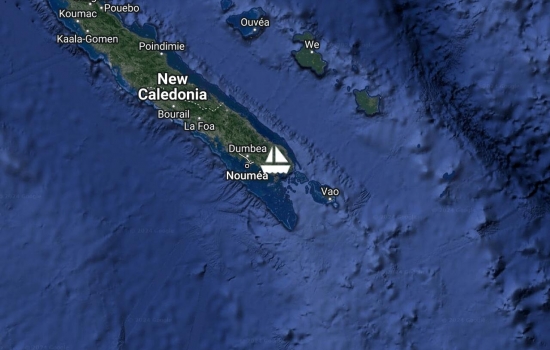
Avg: 7.8knts
24hr: 188nm
Well, we made it! We even made it before the forecast strong winds set-in! We're presently anchored in a pristine little bay on the southern end of the mainland, called Baie Alric. Sheltered perfectly from the strong north-westerlies, it's also the very first bay that Kate, Harry and I anchored in when we arrived in New Caledonia the last time - so some nice memories of the place. Since we arrived, two other boats have pulled-in and anchored beside us (French boats, so naturally, anchored far too close for comfort!) to shelter with us. We're all flying our yellow 'Quarantine' flags indicating that we've just arrived from overseas and haven't cleared-in to the country yet. It would be nice to jump in the dinghy and ask the other boaties where they're from and how their trip was. But that, of course, isn't alowed whilst in 'Quarantine' so no one's being very sociable. That said, it could also be because of the gale-force wind that's trying to yank our anchors up off the bottom and send us crashing into the nearby shore, or possibly because of the horizontal rain that's accompanying it! Sigh. Still, at least the rain is warm!
It's been an odd passage up from New Zealand. A gale-force opening, a day of no wind, a day of 20kts on the beam (so fast and bouncy), followed by two days of no wind with the looming threat of a big, powerful weather front so running the engine hard to get into New Caledonia before it arrived. Of course, the wind arrived just as we entered the pass into the reef-strewn waters around the mainland. Some would say that flying among the reefs at 9 knots, in the dark, in 25kts of breeze, with a relatively inexperienced crew, is precisely what you should *never* do! Still, if we hadn't moved quickly it would have been all those things but with 40 knots of wind. In our defence, I'd sailed the precise route a couple of times before so it wasn't completely uncharted waters. Still, with the sails reefed-down to mere handkerchief size, we rocketed along the designated channels between the reefs (thank goodness for the quality of French navigation-aids: channels and markers, etc) until eventually we found the lee of the mainland and wind dropped to nothing. Big, deep breath. Some excellent helming by Jason who steered the whole way with excellent precision, and fabulous sail trimming by Paul & Ermina who ensured the boat was never over-powered so that Jason had good control the whole time. Naturally, I just slept the whole way! Lol! No, I directed the whole adventure, nervously scanning the darkness with the binoculars picking out the channel markers, hazard markers, lighthouses and other vessels, while continuously comparing the reading from the depth sounder to the depths shown on the chart. Quite a team!
At one point, we were following the designated route between the reefs (that's a route that's marked on the chart which isn't so well established as to be considered a 'channel' but which is routinely used by ferries, cargo ships, passenger liners and fishing boats.) A sharp turn to the left was coming-up with reefs on either side - so some precision steering required - when it became apparent that a cargo ship was coming the other way. Naturally, it would approach the corner at precisely the same time we would. Our clever AIS box spotted what it felt was an upcoming collision (ie. that we'd soon be coming within a mile of another vessel) and sounded alarms and flashed dire warnings, helpfully letting us know that the end was near. However, we were confident that if we and the other vessel stayed on our respective sides of the route (ie. drove on the right side of the road) everything would be fine, but it took some courage to keep our cool and stay on course. Fortunately we were saved from having our (my) navigational decisions put to the test by the fact that the cargo ship turned onto a different route before it reached the tight corner. It had been like a question on a navigation examination. I think we passed :-)
Anyway, we're here now, using the day to shelter from the wind and eat as much of the fresh food we brought with us as possible before the local authorities take it from us. Having over-estimated the number of eggs we'd need for this trip, my cholesterol level is now at an all-time high! Tomorrow morning we'll motor (through the likely windless conditions) for 3 hours up to Noumea and clear in. Then it's a week of rest before the next leg of the journey: The Great Barrier Reef and on to Thursday Island in the Torres Strait.
Tony
Following encouragement by
Hi Tony,
Oops!.... posted my comment
Hi Tony, it is great to hear
I love hearing how it's going
Pages
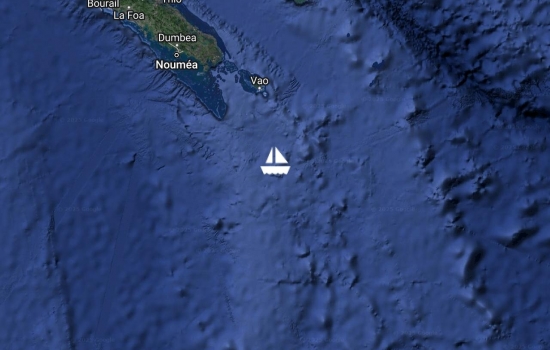
Avg: 8.2knts
24hr: 196.8nm
Well it's been a couple of uneventful days - very little wind so motoring. Still motoring in fact. Of the 5.5 days it will likely take us to reach New Caledonia, it looks like we'll have spent 3 of them with the motor running, sigh! Still, we knew that before we left so can't complain.
We're motoring now in a light breeze in which we would otherwise sail, but there's a bit of a blow coming tonight/tomorrow and if we can keep our speed up, we'll be in New Cal - in nice protected spot - before it sets-in. So we'll motor-sail the last 100 miles and hope we beat the wind. Have to refill with diesel when we get there though - it's been an expensive trip fuel-wise! Last night was something very special however. The absence of any wind for nearly two days left the sea surface mirror-smooth. The moon didn't come up until 2am or so, so it was very dark and there were no clouds. The stars were mind-boggling. Actually, double-mind-boggling since they were reflected perfectly off the surface of the sea. There was no horizon to be seen - the starry sky just continued downwards. We could have been flying through space with stars all around us. The only reminder that we were on the ocean (aside from the noise of the diesel engine) was the phosphoresence that illuminated the bow-wave we were creating as we pushed through the water. Like a spray of fairy-dust thrown out on each side of the boat, the sparkles could have been new stars being born. I've never seen anything quite like it - mind-blowing! So another 50 miles to the Isle of Pines, then 50 miles from there to Baie De Prony where we're planning to ride out the wind at anchor and get some sleep. Thanks goodness I've been here before and know the route - the chart of New Caledonia is pretty intimidating what with all the reefs and islands spread around! We should be anchoring tonight all going well. Originally we'd planned to go straight to Noumea and take care of the administrative paperwork, but that would've meant riding-out the wind at sea. So we'll take a day-off and do it a day later.
Tony
I thought you are a "low risk
What a wonderful description.
Your description of that
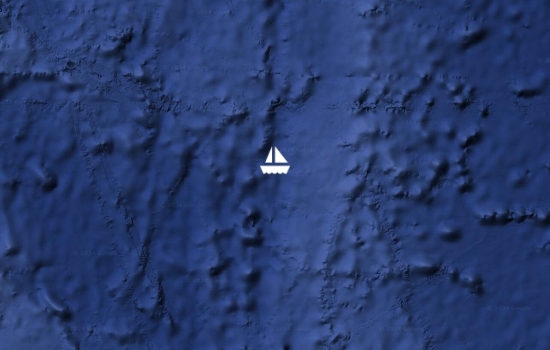
We departed Opua Marina the day before yesterday at about 3:30pm with some trepidation as we expected strong Southerly winds from a passing storm. We weren't disappointed with sustained winds upto 40-45 kts (and gusts I don't even want to contemplate), fortunately from the ideal direction and with almost no ocean swell but incredibly cold. So we reefed down and held the wind over port aft quarter, rocketing northwards on a deep broad reach, switching helmsmen every hour so they could go below and warm up. It made for a loooong night! We left when we did because we knew that the Southerly wouldn't last long and we'd be motoring for a while once it had died down. And just as the forecast predicted, 24 hours later the engine came on and we motored through the night with next to no wind. Still motoring in fact, now 225 miles ESE of Norfolk Island. There are faint signs of the wind returning from the East, but the most notable thing about it is that it's *WARM*! Thank goodness!! So with 308 miles behind us and another 588 to go, we can finally begin to shed the fleeces and beanie-hats :-) We had a brief scare last night when the autopilot stopped working! Too dark to investigate, this wasn't a good omen! We'd barely started using the thing since we'd had to manually steer through the strong winds on leaving NZ. I pulled the contents of the cockpit locker out onto the deck, and as I had during my last departure from NZ up to Fiji, lowered myself into the bottom of the boat to see what was wrong with it. Fortunately, it turned out to be a loose wire - my forte - and I had it going again in a jiffy. We've all celebrated with hot showers, a bacon sandwich, and a spirited discussion of the shortcomings of the autopilot's helmsmanship. Hopefully the wind will be back soon :-) Tony
Hi Tony and crew,
No blogs available for this yacht.

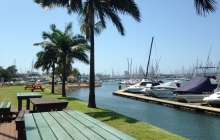

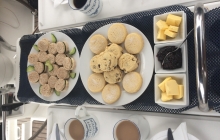
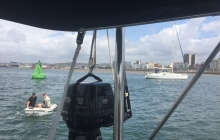
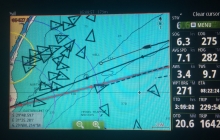
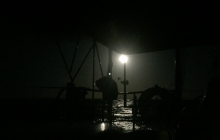
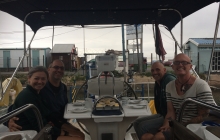
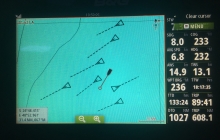

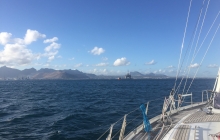


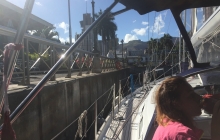
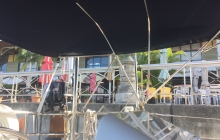
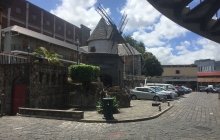
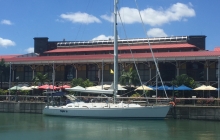
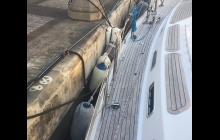
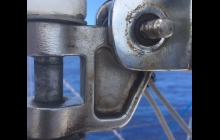
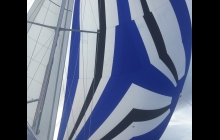
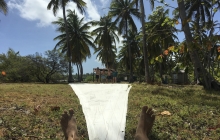

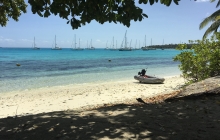
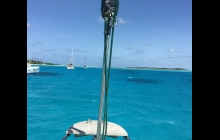
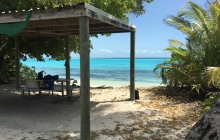
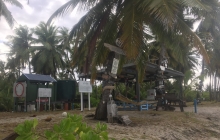
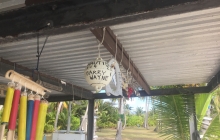
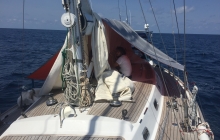
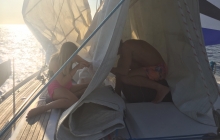

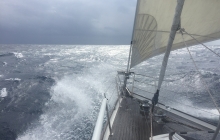

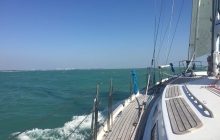

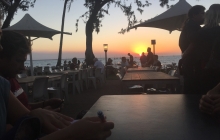
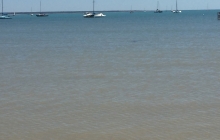
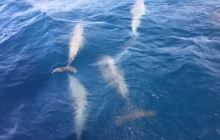
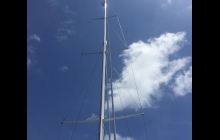
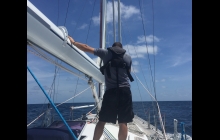
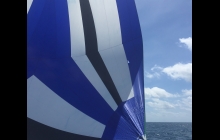
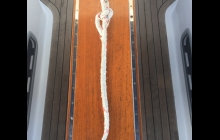
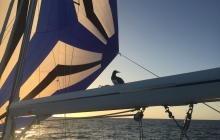
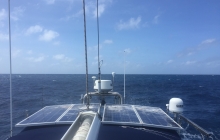
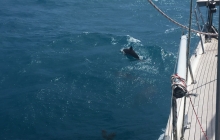

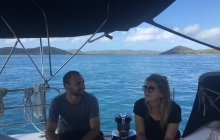
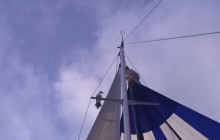

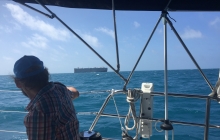

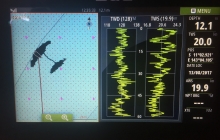
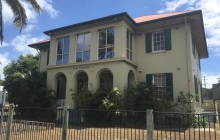
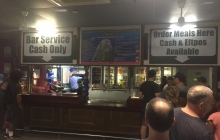

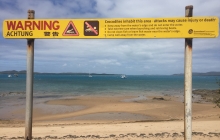

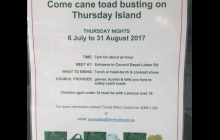
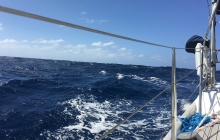

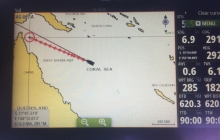
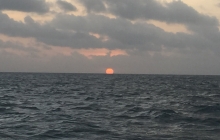
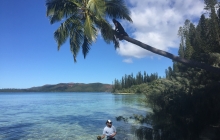
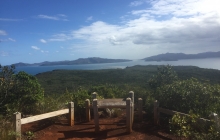
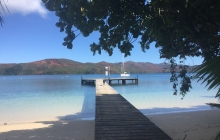
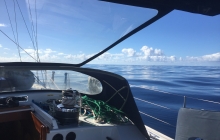

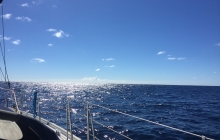
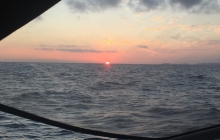
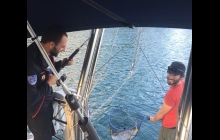
Hi Tony, just a message to
So pleased to hear rigging